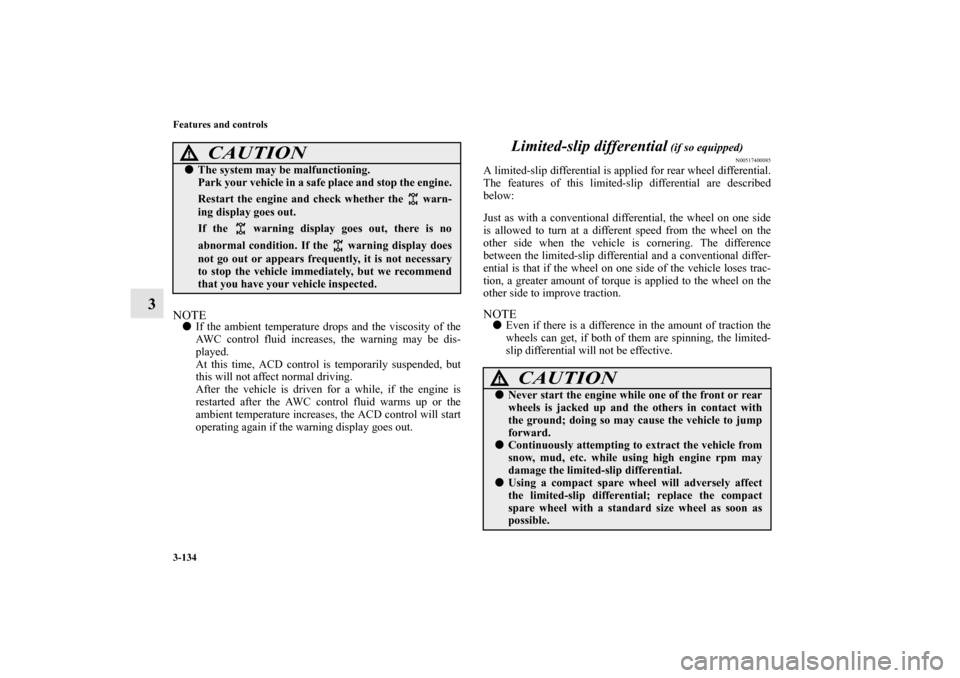Page 224 of 706

Features and controls
3-129
3 All-wheel drive system
(if so equipped)
N00516400046
All-wheel drive vehicles are propelled by engine power distrib-
uted constantly and appropriately to all four wheels.
Not only does this ensure enhanced handling on dry, paved
roads but also permits better traction when driving on slippery,
wet or snow-covered roads and when moving out of mud.
These vehicles, however, are not designed for off-road use,
and are unsuitable for driving on bumpy ground that may
cause excessive strain. All-wheel drive vehicles should be
driven only under the same conditions as are suitable for ordi-
nary front-wheel drive vehicles.
Cautions on handling of all-wheel drive
vehicles
N00530800158
Tires and wheelsSince driving torque can be applied to the four wheels, the
driving performance of the vehicle when operating in all-wheel
drive is greatly affected by the condition of the tires.
Pay close attention to the tires.
�Install only the specified tires on all wheels. Refer to
“Tires and wheels” on page 9-9.
�Be sure all four tires and wheels are the same size and
type.
When it is necessary to replace any of the tires or wheels,
replace all four.
�All tires should be rotated before the wear difference
between the front and rear tires is recognizable.
Good vehicle performance cannot be expected if there is a dif-
ference in wear between tires. Refer to “Tire rotation” on page
7-37.
�Check the tire inflation pressure regularly.
BK0125300US.book 129 ページ 2010年5月18日 火曜日 午後1時53分
Page 229 of 706

3-134 Features and controls
3
NOTE�If the ambient temperature drops and the viscosity of the
AWC control fluid increases, the warning may be dis-
played.
At this time, ACD control is temporarily suspended, but
this will not affect normal driving.
After the vehicle is driven for a while, if the engine is
restarted after the AWC control fluid warms up or the
ambient temperature increases, the ACD control will start
operating again if the warning display goes out.
Limited-slip differential
(if so equipped)
N00517400085
A limited-slip differential is applied for rear wheel differential.
The features of this limited-slip differential are described
below:
Just as with a conventional differential, the wheel on one side
is allowed to turn at a different speed from the wheel on the
other side when the vehicle is cornering. The difference
between the limited-slip differential and a conventional differ-
ential is that if the wheel on one side of the vehicle loses trac-
tion, a greater amount of torque is applied to the wheel on the
other side to improve traction.NOTE�Even if there is a difference in the amount of traction the
wheels can get, if both of them are spinning, the limited-
slip differential will not be effective.
CAUTION
!�The system may be malfunctioning.
Park your vehicle in a safe place and stop the engine.
Restart the engine and check whether the warn-
ing display goes out.
If the warning display goes out, there is no
abnormal condition. If the warning display does
not go out or appears frequently, it is not necessary
to stop the vehicle immediately, but we recommend
that you have your vehicle inspected.
CAUTION
!�Never start the engine while one of the front or rear
wheels is jacked up and the others in contact with
the ground; doing so may cause the vehicle to jump
forward.�Continuously attempting to extract the vehicle from
snow, mud, etc. while using high engine rpm may
damage the limited-slip differential.�Using a compact spare wheel will adversely affect
the limited-slip differential; replace the compact
spare wheel with a standard size wheel as soon as
possible.
BK0125300US.book 134 ページ 2010年5月18日 火曜日 午後1時53分
Page 572 of 706
For emergencies
6-17
6
8. Lower the vehicle slowly by rotating the wheel nut
wrench counterclockwise until the tire touches the
ground.9. Tighten the nuts in the order shown in the illustration until
each nut has been tightened to the torque listed here.
65 to 80 ft-lb (88 to 108 N•m)
10. Lower the jack all the way and remove it.
CAUTION
!�Never use your foot or a pipe extension to apply
added force to the wheel nut wrench when tighten-
ing the wheel nuts. If you do so, you can over-tighten
the wheel nuts and damage the wheel, wheel nuts
and hub bolts.
BK0125300US.book 17 ページ 2010年5月18日 火曜日 午後1時53分